药学英语名词解释整理
- 格式:doc
- 大小:31.00 KB
- 文档页数:2
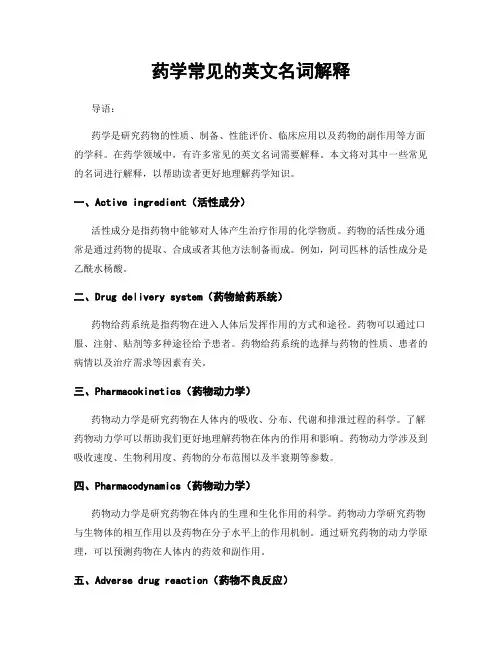
药学常见的英文名词解释导语:药学是研究药物的性质、制备、性能评价、临床应用以及药物的副作用等方面的学科。
在药学领域中,有许多常见的英文名词需要解释。
本文将对其中一些常见的名词进行解释,以帮助读者更好地理解药学知识。
一、Active ingredient(活性成分)活性成分是指药物中能够对人体产生治疗作用的化学物质。
药物的活性成分通常是通过药物的提取、合成或者其他方法制备而成。
例如,阿司匹林的活性成分是乙酰水杨酸。
二、Drug delivery system(药物给药系统)药物给药系统是指药物在进入人体后发挥作用的方式和途径。
药物可以通过口服、注射、贴剂等多种途径给予患者。
药物给药系统的选择与药物的性质、患者的病情以及治疗需求等因素有关。
三、Pharmacokinetics(药物动力学)药物动力学是研究药物在人体内的吸收、分布、代谢和排泄过程的科学。
了解药物动力学可以帮助我们更好地理解药物在体内的作用和影响。
药物动力学涉及到吸收速度、生物利用度、药物的分布范围以及半衰期等参数。
四、Pharmacodynamics(药物动力学)药物动力学是研究药物在体内的生理和生化作用的科学。
药物动力学研究药物与生物体的相互作用以及药物在分子水平上的作用机制。
通过研究药物的动力学原理,可以预测药物在人体内的药效和副作用。
五、Adverse drug reaction(药物不良反应)药物不良反应是指在正常使用或治疗范围内,药物对人体产生的有害的、非预期的反应。
药物不良反应可以包括过敏反应、中毒反应、药物相互作用等。
了解药物不良反应对于合理用药和提高药物安全性至关重要。
六、Pharmaceutical formulation(药物制剂)药物制剂是指将活性成分与辅料以一定比例混合,经过制备工艺制成的制剂形式,便于患者使用的药物形式。
药物制剂包括片剂、注射剂、栓剂、乳剂等。
药物制剂的选择将根据药物的性质和治疗的需要来确定。
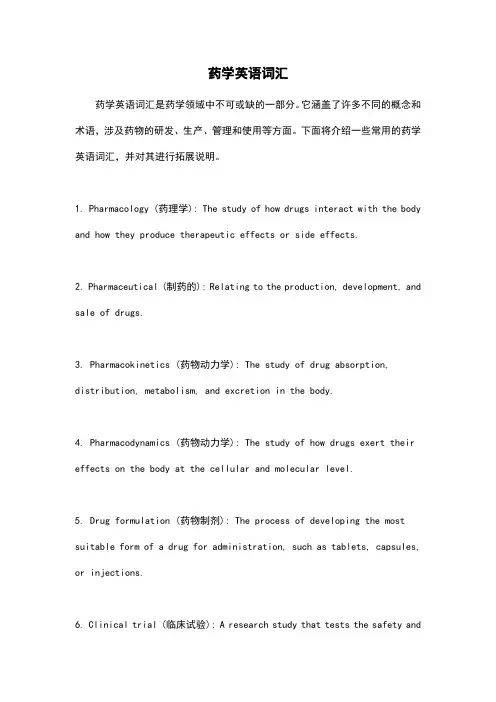
药学英语词汇药学英语词汇是药学领域中不可或缺的一部分。
它涵盖了许多不同的概念和术语,涉及药物的研发、生产、管理和使用等方面。
下面将介绍一些常用的药学英语词汇,并对其进行拓展说明。
1. Pharmacology (药理学): The study of how drugs interact with the body and how they produce therapeutic effects or side effects.2. Pharmaceutical (制药的): Relating to the production, development, and sale of drugs.3. Pharmacokinetics (药物动力学): The study of drug absorption, distribution, metabolism, and excretion in the body.4. Pharmacodynamics (药物动力学): The study of how drugs exert their effects on the body at the cellular and molecular level.5. Drug formulation (药物制剂): The process of developing the most suitable form of a drug for administration, such as tablets, capsules, or injections.6. Clinical trial (临床试验): A research study that tests the safety andeffectiveness of a new drug or treatment in humans.7. Drug interaction (药物相互作用): The effects that occur when two or more drugs are taken together, which can alter their individual therapeutic effects or cause adverse reactions.8. Adverse drug reaction (药物不良反应): Any harmful or unintended response to a drug, which may range from mild to severe.9. Pharmacist (药剂师): A healthcare professional who is knowledgeable about drugs, their uses, and their potential side effects, and who dispenses medications to patients.10. Prescription (处方): A written order from a healthcare provider fora specific medication, including dosage instructions and duration of treatment.11. Over-the-counter (OTC) (非处方药): Medications that can be purchased without a prescription, typically used to treat minor ailments and symptoms.12. Generic drug (仿制药): A medication that is equivalent to a brand-namedrug in terms of active ingredients, dosage form, strength, and route of administration, but is usually less expensive.13. Drug resistance (药物抗性): The ability of microorganisms or cancer cells to survive and multiply despite the presence of a drug, making the treatment less effective.14. Pharmacovigilance (药品监测): The science and activities related to the detection, assessment, understanding, and prevention of adverse effects or any other drug-related problems.15. Drug delivery system (药物输送系统): The technology or method by whicha drug is administered to the body, including oral, transdermal, inhalation, and intravenous routes.以上这些药学英语词汇不仅在医药领域中广泛使用,而且对于学习和理解药物的研发、使用和管理至关重要。
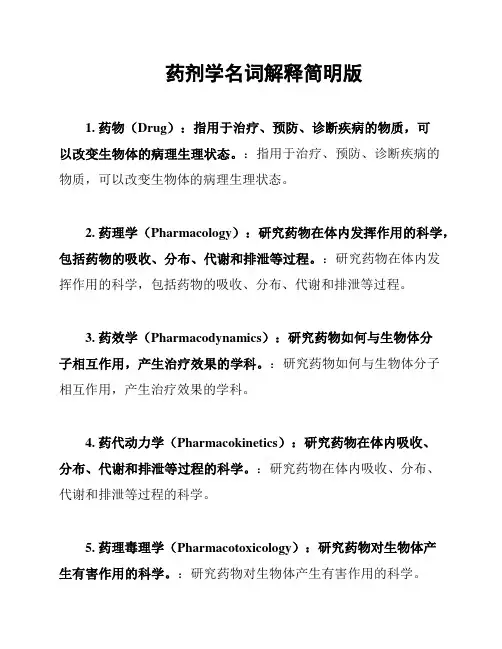
药剂学名词解释简明版1. 药物(Drug):指用于治疗、预防、诊断疾病的物质,可以改变生物体的病理生理状态。
:指用于治疗、预防、诊断疾病的物质,可以改变生物体的病理生理状态。
2. 药理学(Pharmacology):研究药物在体内发挥作用的科学,包括药物的吸收、分布、代谢和排泄等过程。
:研究药物在体内发挥作用的科学,包括药物的吸收、分布、代谢和排泄等过程。
3. 药效学(Pharmacodynamics):研究药物如何与生物体分子相互作用,产生治疗效果的学科。
:研究药物如何与生物体分子相互作用,产生治疗效果的学科。
4. 药代动力学(Pharmacokinetics):研究药物在体内吸收、分布、代谢和排泄等过程的科学。
:研究药物在体内吸收、分布、代谢和排泄等过程的科学。
5. 药理毒理学(Pharmacotoxicology):研究药物对生物体产生有害作用的科学。
:研究药物对生物体产生有害作用的科学。
6. 剂量(Dosage):用量的量度,通常以药物的质量或体积表示。
:用量的量度,通常以药物的质量或体积表示。
7. 药代动力学参数(Pharmacokinetic Parameters):用来描述药物在体内吸收、分布、代谢和排泄等过程的数值指标,如药物半衰期、清除率等。
:用来描述药物在体内吸收、分布、代谢和排泄等过程的数值指标,如药物半衰期、清除率等。
8. 给药途径(Route of Administration):药物进入体内的途径,如口服、注射、局部应用等。
:药物进入体内的途径,如口服、注射、局部应用等。
9. 药物相互作用(Drug Interaction):指两个或多个药物同时使用时相互影响的现象,可能导致药效的增强或减弱,甚至产生不良反应。
:指两个或多个药物同时使用时相互影响的现象,可能导致药效的增强或减弱,甚至产生不良反应。
10. 药物副作用(Adverse Drug Reaction):治疗或预防疾病过程中,药物除了期望的治疗效果外,还会引起的有害反应。
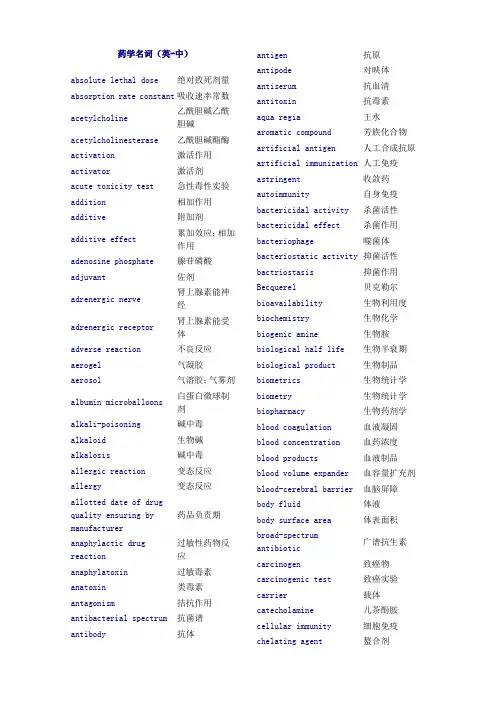
药学名词(英-中)absolute lethal dose绝对致死剂量absorption rate constant吸收速率常数acetylcholine 乙酰胆碱乙酰胆碱acetylcholinesterase乙酰胆碱酯酶activation激活作用activator激活剂acute toxicity test急性毒性实验addition相加作用additive附加剂additive effect 累加效应;相加作用adenosine phosphate腺苷磷酸adjuvant佐剂adrenergic nerve 肾上腺素能神经adrenergic receptor 肾上腺素能受体adverse reaction不良反应aerogel气凝胶aerosol气溶胶;气雾剂albumin microballoons 白蛋白微球制剂alkali-poisoning碱中毒alkaloid生物碱alkalosis碱中毒allergic reaction变态反应allergy变态反应allotted date of drugquality ensuring bymanufacturer药品负责期anaphylactic drug reaction 过敏性药物反应anaphylatoxin过敏毒素anatoxin类毒素antagonism拮抗作用antibacterial spectrum抗菌谱antibody抗体antigen抗原antipode对映体antiserum抗血清antitoxin抗毒素aqua regia王水aromatic compound芳族化合物artificial antigen人工合成抗原artificial immunization人工免疫astringent收敛药autoimmunity自身免疫bactericidal activity杀菌活性bactericidal effect杀菌作用bacteriophage噬菌体bacteriostatic activity抑菌活性bactriostasis抑菌作用Becquerel贝克勒尔bioavailability生物利用度biochemistry生物化学biogenic amine生物胺biological half life生物半衰期biological product生物制品biometrics生物统计学biometry生物统计学biopharmacy生物药剂学blood coagulation血液凝固blood concentration血药浓度blood products血液制品blood volume expander血容量扩充剂blood-cerebral barrier血脑屏障body fluid体液body surface area体表面积broad-spectrumantibiotic广谱抗生素carcinogen致癌物carcinogenic test致癌实验carrier载体catecholamine儿茶酚胺cellular immunity细胞免疫chelating agent螯合剂chemical analysis化学分析chemical disinfection化学消毒法chemical physics化学物理学chemotherapy化学药物治疗chewable tablets嚼用片chiral drug手性药物chlinical pharmacy临床药学cholinesterase胆碱酯酶chronaxia时值chronaxy时值chronic toxicity test慢性毒性实验chronopharmacology时辰药理学chronosusceptability时间感受性chronotherapy时间治疗cipher prescription协定处方clinical pharmacology临床药理学coated tablet包衣片coefficient of diffusion扩散系数coenzyme辅酶cold-storage冷藏complement补体complement system补体系统complete antigen完全抗原complex solubilizer助溶剂concentration浓度content uniformity含量均匀度controlled releasepreparation控释制剂covalent bond共价键crude drugs生药;天然药物cumulative urinary excretion curves 累积尿排泄曲线cytotoxic hexitols 己糖醇细胞毒剂date of expiration药品有效期desiccant干燥剂detoxication解毒作用dextrorotatory form右旋体dextrose右旋糖diffusion扩散directed pharmaceutical preparations定向药物制剂discontinuoussterilization间歇灭菌法disintegrants崩解剂disintegration崩解度dispensing pharmacy调剂学dissolution溶解dissolvent溶剂dissolving溶解dosage剂量dosage form剂型dosage regimen or doserate给药方案或给药速度dose剂量dose or concentrationdependency剂量或浓度的依存性dosing interval给药间隔double-blind technique双盲法drug absorption药物吸收drug accumulation药物蓄积drug administration law药品管理法drug batch number药品批号drug combination合并用药drug distribution药物分布drug elimination药物消除drug excretion药物排泄drug interaction药物相互作用drug metablic enzyme药物代谢酶drug metabolism药物代谢drug reaction药物反应drug sensitive test药敏试验drug standard药品质量标准Drug Standard of Ministryof Public Health of thePeople's Republic ofChina中华人民共和国卫生部药品标准drug tolerance耐药性drug-induced diseases药源性疾病drug-time curve药—时曲线drying agent干燥剂EDO 最大无作用剂量effect效应effective concentration有效浓度effective halt有效半衰期effective rate有效率effector效应器;效应物electrolyte电解质electrolyzation电解elimination rateconstant消除速率常数endotoxin内毒素enteric coating肠溶衣enteric controlledrelease tablets肠溶控释片enterohepaticcirculation肠肝循环environmentalpharmacology环境药理学enzyme酶equivalent law当量定律equivalent weight当量essential aminoacid必需氨基酸essential drugs基本药物essential fatty acid必需脂肪酸ethnopharmacology人种药理学etiological treatment对因治疗excipients辅料excitability兴奋性exotoxin外毒素expiry date药品有效期extravascularadministration血管外给药fatal dose致死量fermentation发酵film-coating薄膜衣filter aid助滤剂filtration过滤first pass effect ofhepar肝首过效应first-pass effect首过效应freezing冷冻gamma rays丙种射线gas analysis气体分析gene基因Geneva nomenclature日内瓦命名法gluconeogenesis糖异生作用glucose-6-phosphatedehydrogenase6-磷酸葡萄糖脱氢酶glycolysis酵解gram molecular weight克分子量gram-atom克原子gram-equivalent number克当量数gram-equivalent weight克当量gram-mol克分子gram-molecule克分子growth curve生长曲线half lethal dose半数致死剂量half life time半衰期half-life period半衰期halogenide卤化物haptene半抗原hemolysis溶血histamine组胺holonzyme and prostheticgroup全酶与辅基hormone激素humoral immunity体液免疫hydrolysis水解(作用)hyperreactivity高敏性immuno inhibitor免疫抑制剂immunoenhancement免疫增强剂immunogenicity免疫原性immunosuppressant免疫抑制剂implants埋植剂incomplete antigen不完全抗原indirect carcinogenesis间接致癌individual differences 个体差异性 individual variation 个体差异性 industrial pharmacy 工业药剂学 inhalation吸入法 innocuity test method 安全试验法 intermediate 中间体 intoxication中毒intracorporal process of drugs 药物的体内过程 intrathecal injection 鞘内注射 intravascular administration 血管内给药 isomerase 异构酶 isotonic solution 等张溶液 isotope同位素 Janbon's syndrome Janbon 综合症 lag time 时滞 LD 100 绝对致死剂量 LD 50 半数致死剂量 LDO最大耐受剂量 least significant difference 最小显著差数 lethal dose 致死量 levorotatory form 左旋体 levulose 左旋糖 light quantum光量子limit date of using a drugafter its production药品使用期Limulus Amebocyte Lysate assay for endotoxin 内毒素鲎试剂测定法 linear correlation 直线相关 liniments 搽剂 liposome脂质体long term toxicity test长期毒性实验;慢性毒性实验 low density lipoprotein 低密度脂蛋白 lysozyme 溶菌酶 macromolecule 大分子 magnetic controlled release dosage form磁性控释制剂magnetic medicinal preparations 磁性药物制剂 materia medica药物学maxial noneffective dose最大无作用剂量 maximal tolerable dose 最大耐受剂量 median lethal dose 半数致死剂量 mediator介质 medical colloidal solution 胶体溶液型药剂 medium介质 mesomer内消旋体 microsomal enzyme微粒体酶minimal effective dose 最小有效量 minimal lethal dose 最小致死剂量 mixture 合剂 MLD最小致死剂量 mol fraction concentration 摩尔分数浓度 molal comcentration 克分子浓度 molar comcentratin 克分子浓度 molar fraction 克分子分数 molar volume 摩尔分子体积 molarity 摩尔浓度 mole 摩尔 mole volume 摩尔分子体积 molecular biology 分子生物学 molecular disease分子病molecular pharmacology 分子药理学 molecular solution 分子溶液 monoclonal antibody单克隆抗体multifunctional enzyme 多功能酶 multiple doseadministration 多剂量给药 mutation 突变 natural antibody 天然抗体 natural antigen 天然抗原 natural drugs 天然药物 natural immunity天然免疫neurotoxin神经毒素nitrite poisoning亚硝酸盐中毒nitrohydrochloric acid王水non-essential amino acid非必需氨基酸nondepolarizer 非去极化型肌松药normal solution当量溶液normality当量浓度nucleotide核苷酸nutrient营养素ocular inserts眼用膜剂official formula法定处方oligosaccharides低聚糖oral administration口腔内给药oral medicaed solublepaper纸型片剂osmotic pressure渗透压parts per billionconcentrationPPB浓度parts per hundredconcentrationPPH浓度parts per hundred million concentrationpphm浓度parts per millionconcentrationppm浓度passive immunity被动免疫passive transport被动转运peak concentration ofdrug药峰浓度peak time of drug药峰时间penetration enhancers穿透促进剂percentage concentration百分浓度phagocytosis吞噬作用pharmaceutical analysis药物分析pharmaceutical chemistry药物化学pharmaceuticalequivalence药剂等效性pharmaceutics药剂学pharmacodynamics药效动力学pharmacogenetics药物遗传学pharmacokinetics model药物动力学模型pharmacology药理学;药物学physical dependence身体依赖性physical pharmaceutics物理药剂学pill滴丸剂placebo安慰剂plasma血浆plasma protein bindingratio血浆蛋白结合率plasma substitute血浆代用液plaster硬膏剂poisoning中毒polyose多糖polypeptide多肽potency效价;效价强度potency unit效价单位powerful drug剧药preparation制剂prescription处方prodrug前体药物proenzyme酶原prohormone激素原prolonged actionpreparation长效制剂prosthetic group辅基psychic dependence精神依赖性quantum pharmacology量子药理学raceme外消旋体radiopharmaceutics放射药剂学radiotoxicology放射毒理学receptor感受器;受体receptor antagonist受体拮抗剂receptor stimulant受体激动剂recipe处方rectal administration直肠给药refrigeration冷冻relative dosage interval相对给药间隔resistance to drugs抗药性restrictive holagogue限制性剧药ribonucleic acid核糖核酸RNA核糖核酸safety coefficient安全系统safety range安全范围saponins皂甙saturated solution饱和溶液selectivity选择性semi-logarithmic curve of drug-time 药—时半对数曲线semisyntheticantibiotics半合成抗生素sensitivity敏感性sensitization致敏作用sensitization test致敏试验sequential design序贯设计serum血清short term carcinogenictest短期致癌实验side effect副作用skin and mucocutaneous administration 皮肤、粘膜表面给药slow pathway慢通道solute溶质solvent溶剂steady state plasmaconcentration稳态血药浓度steroid withdrawal syndrome 类固醇停药综合征subacute intoxication亚急性中毒subacute poisoning亚急性中毒superinfection二重感染superoxide过氧化物surface activity表面活性surface tension表面张力suspending agent助悬剂suspension悬浮液symptomatic treatment对症治疗synergism协同作用synthetic drugs合成药物tablet hardness片剂硬度tachyphylaxis快速耐受target cell靶细胞targetable drug delivery向靶给药TDM治疗药物临测technology ofpharmaceutics制剂学teratogen致畸物teratogenic test致畸试验the Merck index默克索引therapeutic action治疗作用therapeutic dose治疗量therapeutic drugmonitoring治疗药物临测therapeutic equivalence治疗等效(值)therapeutic index TI治疗指数threshold dose阈剂量time-effect relationship时效关系tincture酊剂titration滴定titration curve滴定曲线tolerance耐受性toxic reaction毒性反应toxic response毒性反应toxicology毒理学toxoid类毒素trace element痕量元素;微量元素transmitter递质;介质tricarboxylic acid cycle三羧酸循环volume by volumeconcentration体积比浓度WHO世界卫生组织World HealthOrganization世界卫生组织药名常用词首药名常用词干一、抗微生物药二、抗寄生虫药三、神经系统药四、心血管系统药五、影响血液及造血系统药六、消化系统药七、呼吸系统药八、利尿药九、抗肿瘤药十、激素类药十一、降血糖药 十二、抗变态反应药 十三、前列腺素类药 十四、免疫系统药十五、酶类药及其抑制药十六、诊断用药 十七、其他药名常用词尾。
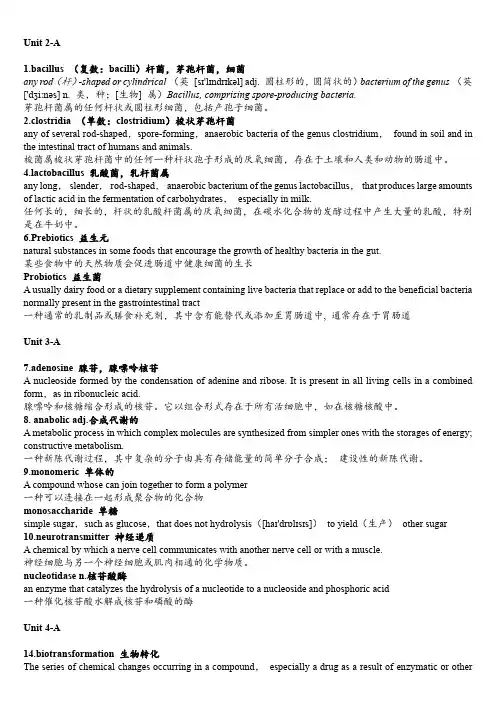
Unit 2-A1.bacillus (复数:bacilli)杆菌,芽孢杆菌,细菌any rod(杆)-shaped or cylindrical (英[sɪ'lɪndrɪkəl] adj. 圆柱形的,圆筒状的)bacterium of the genus(英['dʒiːnəs] n. 类,种;[生物] 属)Bacillus, comprising spore-producing bacteria.芽孢杆菌属的任何杆状或圆柱形细菌,包括产孢子细菌。
2.clostridia (单数:clostridium)梭状芽孢杆菌any of several rod-shaped,spore-forming,anaerobic bacteria of the genus clostridium,found in soil and in the intestinal tract of humans and animals.梭菌属梭状芽孢杆菌中的任何一种杆状孢子形成的厌氧细菌,存在于土壤和人类和动物的肠道中。
ctobacillus 乳酸菌,乳杆菌属any long,slender,rod-shaped,anaerobic bacterium of the genus lactobacillus,that produces large amounts of lactic acid in the fermentation of carbohydrates,especially in milk.任何长的,细长的,杆状的乳酸杆菌属的厌氧细菌,在碳水化合物的发酵过程中产生大量的乳酸,特别是在牛奶中。
6.Prebiotics 益生元natural substances in some foods that encourage the growth of healthy bacteria in the gut.某些食物中的天然物质会促进肠道中健康细菌的生长Probiotics 益生菌A usually dairy food or a dietary supplement containing live bacteria that replace or add to the beneficial bacteria normally present in the gastrointestinal tract一种通常的乳制品或膳食补充剂,其中含有能替代或添加至胃肠道中, 通常存在于胃肠道Unit 3-A7.adenosine 腺苷,腺嘌呤核苷A nucleoside formed by the condensation of adenine and ribose. It is present in all living cells in a combined form,as in ribonucleic acid.腺嘌呤和核糖缩合形成的核苷。

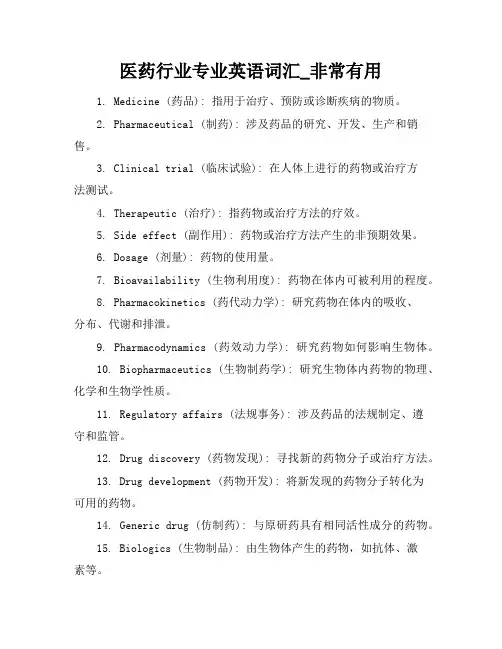
医药行业专业英语词汇_非常有用1. Medicine (药品): 指用于治疗、预防或诊断疾病的物质。
2. Pharmaceutical (制药): 涉及药品的研究、开发、生产和销售。
3. Clinical trial (临床试验): 在人体上进行的药物或治疗方法测试。
4. Therapeutic (治疗): 指药物或治疗方法的疗效。
5. Side effect (副作用): 药物或治疗方法产生的非预期效果。
6. Dosage (剂量): 药物的使用量。
7. Bioavailability (生物利用度): 药物在体内可被利用的程度。
8. Pharmacokinetics (药代动力学): 研究药物在体内的吸收、分布、代谢和排泄。
9. Pharmacodynamics (药效动力学): 研究药物如何影响生物体。
10. Biopharmaceutics (生物制药学): 研究生物体内药物的物理、化学和生物学性质。
11. Regulatory affairs (法规事务): 涉及药品的法规制定、遵守和监管。
12. Drug discovery (药物发现): 寻找新的药物分子或治疗方法。
13. Drug development (药物开发): 将新发现的药物分子转化为可用的药物。
14. Generic drug (仿制药): 与原研药具有相同活性成分的药物。
15. Biologics (生物制品): 由生物体产生的药物,如抗体、激素等。
16. Overthecounter (OTC) drug (非处方药): 不需要医生处方即可购买的药物。
17. Prescription drug (处方药): 需要医生处方才能购买的药物。
18. Drug interaction (药物相互作用): 两种或多种药物同时使用时产生的相互作用。
19. Adverse event (不良事件): 在药物使用过程中出现的非预期反应。
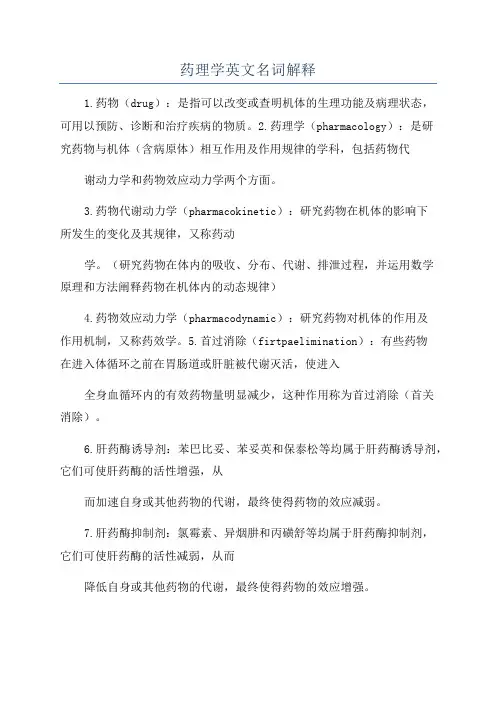
药理学英文名词解释1.药物(drug):是指可以改变或查明机体的生理功能及病理状态,可用以预防、诊断和治疗疾病的物质。
2.药理学(pharmacology):是研究药物与机体(含病原体)相互作用及作用规律的学科,包括药物代谢动力学和药物效应动力学两个方面。
3.药物代谢动力学(pharmacokinetic):研究药物在机体的影响下所发生的变化及其规律,又称药动学。
(研究药物在体内的吸收、分布、代谢、排泄过程,并运用数学原理和方法阐释药物在机体内的动态规律)4.药物效应动力学(pharmacodynamic):研究药物对机体的作用及作用机制,又称药效学。
5.首过消除(firtpaelimination):有些药物在进入体循环之前在胃肠道或肝脏被代谢灭活,使进入全身血循环内的有效药物量明显减少,这种作用称为首过消除(首关消除)。
6.肝药酶诱导剂:苯巴比妥、苯妥英和保泰松等均属于肝药酶诱导剂,它们可使肝药酶的活性增强,从而加速自身或其他药物的代谢,最终使得药物的效应减弱。
7.肝药酶抑制剂:氯霉素、异烟肼和丙磺舒等均属于肝药酶抑制剂,它们可使肝药酶的活性减弱,从而降低自身或其他药物的代谢,最终使得药物的效应增强。
8.肝肠循环:经胆汁排入肠腔的药物部分可再经小肠上皮细胞吸收经肝脏进入血循环,这种肝脏、胆汁、小肠间的循环称为肝肠循环。
9.一级消除动力学:是体内药物在单位时间内消除的药物百分率不变,也就是单位时间内消除的药物量与血浆药物浓度成正比,是药物在体内消除的一种方式。
10.零级消除动力学:是药物在体内以恒定的速率消除,即不论血浆药物浓度高低,单位时间内消除的药物量不变,是药物在体内消除的一种方式。
11.清除半衰期(halflife,t1/2):是血浆药物浓度下降一半时所需要的时间。
12.清除率(clearance,CL):是机体消除器官在单位时间内清除药物的血浆容积,即单位时间内有多少毫升血浆中所含药物被机体清除。
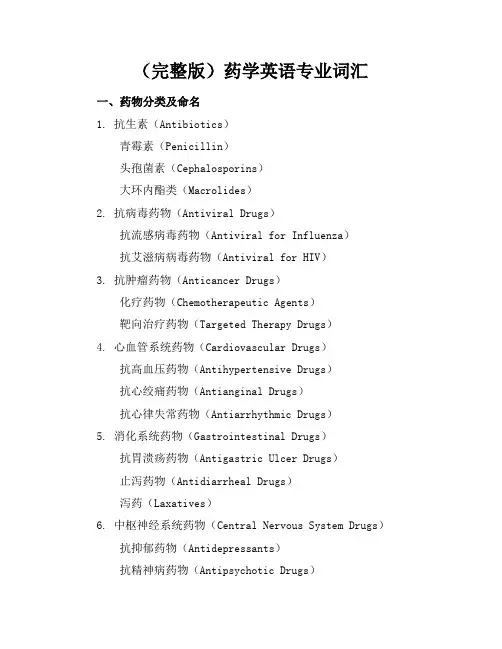
(完整版)药学英语专业词汇一、药物分类及命名1. 抗生素(Antibiotics)青霉素(Penicillin)头孢菌素(Cephalosporins)大环内酯类(Macrolides)2. 抗病毒药物(Antiviral Drugs)抗流感病毒药物(Antiviral for Influenza)抗艾滋病病毒药物(Antiviral for HIV)3. 抗肿瘤药物(Anticancer Drugs)化疗药物(Chemotherapeutic Agents)靶向治疗药物(Targeted Therapy Drugs)4. 心血管系统药物(Cardiovascular Drugs)抗高血压药物(Antihypertensive Drugs)抗心绞痛药物(Antianginal Drugs)抗心律失常药物(Antiarrhythmic Drugs)5. 消化系统药物(Gastrointestinal Drugs)抗胃溃疡药物(Antigastric Ulcer Drugs)止泻药物(Antidiarrheal Drugs)泻药(Laxatives)6. 中枢神经系统药物(Central Nervous System Drugs)抗抑郁药物(Antidepressants)抗精神病药物(Antipsychotic Drugs)镇痛药物(Analgesics)二、药物剂型及给药途径1. 剂型(Dosage Forms)片剂(Tablets)胶囊(Capsules)注射剂(Injections)2. 给药途径(Routes of Administration)口服(Oral)肌内注射(Intramuscular)静脉注射(Intravenous)三、药物作用及不良反应1. 药物作用(Pharmacological Actions)抗菌作用(Antibacterial Action)抗病毒作用(Antiviral Action)镇痛作用(Analgesic Action)2. 不良反应(Adverse Reactions)过敏反应(Allergic Reactions)胃肠道反应(Gastrointestinal Reactions)肝脏毒性(Hepatotoxicity)四、药学专业英语词汇1. 药理学(Pharmacology)药物代谢(Drug Metabolism)药物动力学(Pharmacokinetics)药效学(Pharmacodynamics)2. 药剂学(Pharmaceutics)制剂工艺(Preparation Technology)药物稳定性(Drug Stability)药物质量控制(Drug Quality Control)3. 药物化学(Medicinal Chemistry)药物合成(Drug Synthesis)药物结构(Drug Structure)药物设计(Drug Design)本文档旨在帮助药学专业学生和从业者掌握药学英语专业词汇,提高专业英语水平,为学术交流和临床实践提供便利。
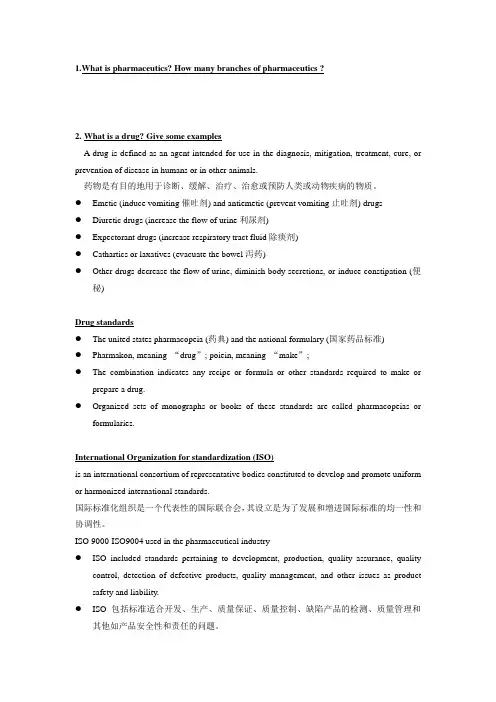
1.What is pharmaceutics? How many branches of pharmaceutics ?2.What is a drug? Give some examplesA drug is defined as an agent intended for use in the diagnosis, mitigation, treatment, cure, or prevention of disease in humans or in other animals.药物是有目的地用于诊断、缓解、治疗、治愈或预防人类或动物疾病的物质。
●Emetic (induce vomiting催吐剂) and antiemetic (prevent vomiting止吐剂) drugs●Diuretic drugs (increase the flow of urine利尿剂)●Expectorant drugs (increase respiratory tract fluid除痰剂)●Cathartics or laxatives (evacuate the bowel泻药)●Other drugs decrease the flow of urine, diminish body secretions, or induce constipation (便秘)Drug standards●The united states pharmacopeia (药典) and the national formulary (国家药品标准)●Pharmakon, meaning “drug”; poiein, meaning “make”;●The combination indicates any recipe or formula or other standards required to make orprepare a drug.●Organized sets of monographs or books of these standards are called pharmacopeias orformularies.International Organization for standardization (ISO)is an international consortium of representative bodies constituted to develop and promote uniform or harmonized international standards.国际标准化组织是一个代表性的国际联合会,其设立是为了发展和增进国际标准的均一性和协调性。
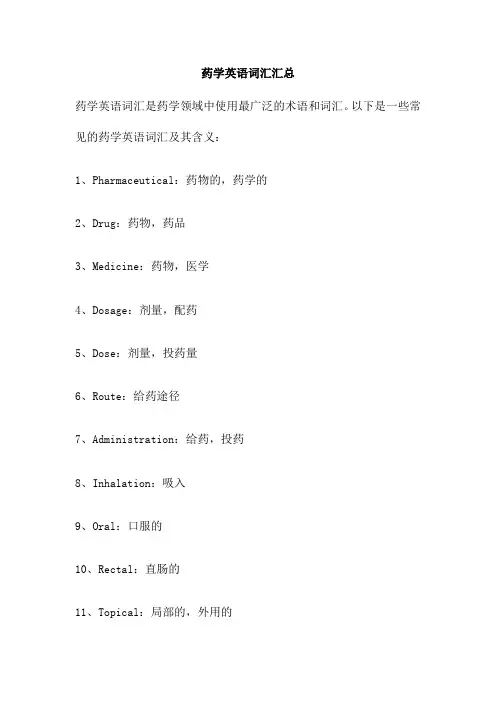
药学英语词汇汇总药学英语词汇是药学领域中使用最广泛的术语和词汇。
以下是一些常见的药学英语词汇及其含义:1、Pharmaceutical:药物的,药学的2、Drug:药物,药品3、Medicine:药物,医学4、Dosage:剂量,配药5、Dose:剂量,投药量6、Route:给药途径7、Administration:给药,投药8、Inhalation:吸入9、Oral:口服的10、Rectal:直肠的11、Topical:局部的,外用的12、Transdermal:透皮吸收的13、Intravenous:静脉注射的14、Intramuscular:肌肉注射的15、Subcutaneous:皮下注射的16、Administration:(给药的)方式,(药物的)投药途径17、Controlled-release dosage form:控释剂型18、Drug interaction:药物相互作用19、Drug resistance:药物耐受性,耐药性20、Toxicity:毒性21、Side effect:副作用22、Overdose:用药过量23、Drug tolerance:药物耐受性,耐药性24、Pharmacokinetics:药物代谢动力学25、Pharmacodynamics:药效学,药物作用动力学26、Pharmacologist:药理学家,药学家27、Pharmacy technician:药房技术员,药剂师助理28、Prescription:处方,药方29、Non-prescription drug:非处方药30、Generic drug:非专利药品,仿制药31、Brand-name drug:品牌药,专利药品32、Formulation:配方,制剂33、Dosage form:剂量形式,剂型在高中英语的学习过程中,词汇的学习是至关重要的环节。
拥有足够的词汇量不仅可以提高阅读理解能力,还能增强写作和口语的表达。
药学英语知识点归纳药学英语是指与药学相关的英语知识。
药学是研究药物的性质、合成、制备、分离、鉴定、药效、药代动力学以及其应用和临床评价的一门科学。
药学英语作为专业英语的一部分,主要包括药学常用词汇、句子结构、专业写作和专业交流等方面的内容。
1. 药学常用词汇在药学英语中,有许多常用的词汇需要掌握。
例如:- drug:药物- medicine:医学;药;医药- dosage:剂量- prescription:处方- pharmacy:药房- pharmaceutical:制药的- efficacy:药效- adverse effect:不良反应- overdose:过量服用- side effect:副作用- contraindication:禁忌症- drug interaction:药物相互作用2. 句子结构掌握药学英语的句子结构对于正确理解和表达药学领域的内容非常重要。
以下是一些常见的句子结构:- 简单句:包括主语、谓语和宾语,用来陈述一个简单的事实或观点。
例如:“The drug is effective for treating hypertension.”- 复合句:包括一个主句和一个或多个从句,用来表达复杂的观点、条件、原因等。
例如:“If the patient has a history of allergic reactions, the drug should be avoided.”- 并列连词:用于连接两个相对 ** 的句子或短语。
例如:“The drug is effective, but it may cause side effects.”- 介词短语:用于描述药物的用法、途径和目的等。
例如:“The medication sho uld be taken before meals.”- 被动语态:用于强调动作的承受者而不是执行者。
例如:“The drug is widely used in clinical practice.”3. 专业写作在药学领域,专业写作是一种常见的沟通方式。
100个药学名词中英文对照1.Adverse effect-不良反应2.Analgesic-镇痛剂3.Antibiotic-抗生素4.Antidepressant-抗抑郁剂5.Antihistamine-抗组胺药6.Anti-inflammatory-抗炎药7.Antipyretic-退热药8.Apothecary-药剂师9.Aspirin-阿司匹林10.Biopharmaceuticals-生物制药11.Capsule-胶囊12.Carcinogen-致癌物13.Clinical trial-临床试验14.Contraindication-禁忌症15.Counterfeit-假冒伪劣的16.Cytotoxic-细胞毒性的17.Dosage-剂量18.Drug interaction-药物相互作用19.Efficacy-疗效20.Excipient-辅料21.FDA-美国食品药品监督管理局22.Generic drug-常规药品23.GMP-药品良好生产规范24.Herbal medicine-中草药25.Hormone-激素26.Iatrogenic-医源性的27.Immunosuppressant-免疫抑制剂28.In vitro-体外实验29.In vivo-体内实验30.Injection-注射剂31.Lethal dose-致死剂量32.Lot number-批号33.Mass spectrometry-质谱分析法34.Medicine-药物35.Narcotic-麻醉剂36.Nebulizer-雾化器37.Ointment-软膏38.Over-the-counter-非处方药39.Parenteral-无肠道给药的40.Pharmaceutical-制药的41.Pharmacodynamics-药效学42.Pharmacokinetics-药代动力学43.Pharmacology-药理学44.Pharmacotherapy-药物治疗学45.Placebo-安慰剂46.Poison-毒药47.Prescription-处方48.Prophylactic-预防性的49.Psychoactive-心理活性的50.Refill-续方51.Side effect-副作用52.Solubility-溶解度53.Solution-溶液54.Sterile-无菌的55.Sublingual-舌下的56.Synergy-协同作用57.Tablet-片剂58.Therapeutic-治疗上的59.Toxicology-毒理学60.Transdermal-经皮的61.Tuberculosis-结核病62.Vial-小瓶63.Anesthetic-麻醉剂64.Antianxiety-抗焦虑药65.Antiarrhythmic-抗心律失常药66.Anticoagulant-抗凝剂67.Anticonvulsant-抗癫痫药68.Antidiabetic-抗糖尿病药69.Antifungal-抗真菌药70.Antineoplastic-抗肿瘤药71.Antipsychotic-抗精神病药72.Antiretroviral-抗逆转录病毒药73.Antitussive-止咳药74.Antiviral-抗病毒药75.Beta blocker-贝塔受体阻滞剂76.Biologic-生物学的77.Blood thinner-血液稀释剂78.Bronchodilator-支气管扩张剂79.Chemotherapy-化疗80.Cholesterol-lowering-降低胆固醇的81.CYP450-细胞色素P45082.Depressant-镇静剂83.Diuretic-利尿剂84.Dose-response-剂量反应85.Enzyme inhibitor-酶抑制剂86.Expiration date-有效期87.Fat soluble-脂溶性的88.Gastrointestinal-胃肠的89.Half-life-半衰期90.Humectant-保湿剂91.Immunoglobulin-免疫球蛋白92.Inotropic-正性肌力药93.Intramuscular-肌肉注射的94.Intravenous-静脉注射的95.Lipid-脂质96.Liposome-脂质体97.Metabolism-新陈代谢98.Microbial-微生物的99.Molecule-分子100.Muscle relaxant-松弛肌肉的。
药学专业名词汉英对照药学专业名词汉英对照当我们学习药学时,经常会遇到很多汉英对照的专业名词。
这些专业名词对于我们学习和理解药学知识非常重要。
在这篇文章中,我们将讲解一些常见的药学专业名词的汉英对照,并对其进行简单的解释,帮助大家更好地理解和记忆这些专业名词。
一、药品分类1. 中成药(Chinese patent medicine)中成药是指具有中药特点,由多种中药组成,经科学制备而成的剂型,在药理作用、药效等方面具有一定的疗效。
2. 化学药(Chemical drug)化学药是指由化学合成或半合成的原材料制造成的药物。
3. 生物制品(Biological products)生物制品是指利用生物技术生产的药物,主要是蛋白质类药物。
二、药剂学1. 溶液(Solution)溶液是一种由溶质溶解在溶剂中而成的均匀混合物,其中溶质可以是单一的化合物或多种化合物的混合物。
2. 粉末(Powder)粉末是一种细小的颗粒状态的药品,通常用于口服剂量的制备。
3. 片剂(Tablet)片剂是一种由药物粉末和辅料制成的固体剂型,具有容易服用,剂型稳定等优点。
4. 胶囊(Capsule)胶囊是一种由药品粉末或液体填充在胶壳内而成的剂型,容易适应不同口服要求,可保护药品免受光、氧、湿等环境因素影响。
5. 滴剂(Drops)滴剂是一种液态剂型,通常用于眼药剂或口服液药剂中。
三、药物剂量和容量单位1. 克(Gram)克是药品剂量和药品容量单位,等于1千分之1千克。
2. 毫克(Milligram)毫克是药品剂量和药品容量单位,等于1千分之1克。
3. 微克(Microgram)微克是药品剂量和药品容量单位,等于1百万分之1克。
4. 升(Litre)升是药品容量单位,等于1000毫升。
四、药物作用和药物代谢1. 药理学(Pharmacology)药理学是指研究药物作用机制,药物在机体内传播、转化、代谢和作用的学科。
2. 代谢(Metabolism)代谢是指机体中对药物进行的化学反应,通过代谢可以将药物从机体中排出,减少药物对机体的毒性作用。
中药学的英文名词解释汇总中药学是研究中药的来源、性质、制备、功效以及中药与人体的相互作用等的学科。
为了更好地理解中药学,下面将介绍一些与中药学相关的英文名词。
一、Pharmacognosy(药用植物学)Pharmacognosy是一个希腊词,由pharmakon(药物)和gnosis(知识)组成,意为药物的知识。
Pharmacognosy是研究草药的来源、特性和用途的学科。
它探讨了草药的生物活性化合物、草药的生长环境、采集和贮藏等方面的知识。
二、Herbalism(草药治疗学)Herbalism是指使用植物中的活性成分进行治疗和预防疾病的做法。
中药学的一部分内容就是研究植物中的化学成分,了解它们的功效和作用机制,并进一步将其应用于临床实践中。
三、Traditional Chinese Medicine(中医学)Traditional Chinese Medicine(TCM)是中国传统医学的缩写。
它基于中国古代医学理论,包括辩证论、阴阳平衡法、五行学说等,并且结合了中药、针灸、按摩等多种疗法。
中医学在中药学中发挥了重要作用,因为中医给予了中药的临床应用指导。
四、Medicinal plants(药用植物)Medicinal plants是指用于治疗疾病的植物,其部分或全部组织具有药理学作用。
这些植物可以使用其根、茎、叶、花或果实,产生治疗作用。
在中药学中,药用植物是主要的药物来源之一,研究这些植物对于发现新药物具有重要意义。
五、Active constituents(活性成分)Active constituents是指草药中具有药理活性的化学成分。
中药学研究活性成分的目的是发现草药的药理作用,并确定草药中起主要作用的特定化学物质。
常见的活性成分包括生物碱、多糖、黄酮类化合物等。
六、Phytochemistry(植物化学)Phytochemistry是研究植物中化学成分的学科。
中药学借助植物化学的方法,分析、鉴定和提取草药中的化学成分,以及研究植物化学物质在体内的吸收、代谢和药理活性。
第一部分1.药物(drug)是指能够影响机体(包括病原体)功能和(或)细胞代谢活动,用于疾病的治疗、预防和诊断,以及计划生育等方面的化学物质。
2.不良反应(adverse drug reaction ADR)是指上市的合格药品在常规用法、用量情况下出现的,与用药目的无关,并给患者带来痛苦或危害的反应。
3.副作用(side effect)是由于药物作用选择性低,作用范围广,在治疗剂量引起的,与用药目的无关的作用。
4.毒性反应(toxic effect)是由于用量过大或用药时间过长引起的严重不良反应。
5.后遗效应(residual effect)是指在停药后,血浆药物浓度下降至阈浓度以下时残存的药理效应。
6.变态反应(allergic reaction)是药物引起的免疫反应,反应性质与药物原有效应无关,其临床表现包括免疫反应的各种类型。
致敏原可以是药物本身或药物代谢产物,亦可能是制剂中的杂质或辅剂。
7.继发反应(secondary reaction)是继发于药物治疗作用之后的不良反应。
8.停药反应(withdrawal reaction)是指患者长期应用某种药物,突然停药后发生病情恶化的现象。
9.特异质反应(idiosyncrasy reaction)是指少数患者由于遗传因素对某些药物的反应性发生了变化。
特异质反应表现为对药物的反应特别敏感,或出现与在常人不同性质的反应。
10.依赖性(dependence)是药物与机体相互作用所造成的一种状态,表现出强迫要求连续或定期使用该药的行为或其他反应,其目的是感受药物的精神效应,或避免由于停药造成身体不适应。
11.量效关系(does-effect relationship)药理效应的强弱与其剂量大小或浓度高低呈一定关系,称剂量-效应关系,简称量效关系。
12.最小有效量(minimal effective does)或最小有效浓度是指引起效应的最小药量或最低药物浓度,亦称阈剂量或阈浓度。
药学专业名词E to C1-NEP N-乙基吡咯酮1-NMP N-甲基吡咯酮2G-β-CYD 二葡糖基--环糊精2-HP-β-CYD 2-羟丙基--环糊精5-NCP 5-羧基吡咯酮5-NMP 5-甲基吡咯酮Accelerated testing 加速试验Acrylic acid resin 丙烯酸树酯Active targeting preparation 主动靶向制剂Adersive dispersion-type TTS 粘胶分散型TTS Adhersive strength 粘附力Adhesion 粘附性Adhesives 粘合剂Aerosil 微粉硅胶Aerosol 气雾剂Aerosol of micropowders for inspiration 吸入粉雾剂Aethylis oleas 油酸乙酯Agglomerate 聚结物Aggregation 聚集Air suspension 空气悬浮法Alarm clock 闹钟Alcohol 乙醇All-trans 全反式Alterntae addition method 两相交替加入法Amebocyte lysate 变形细胞溶解物Amorphous forms 无定型Angle of repose 休止角Antiadherent 抗粘剂Antioxidants 抗氧剂Antisepesis 防腐Apparent solubility 表现溶解度Aprotinin 抑酞酶Aquacoat 乙基纤维素水分散体Aromatic waters 芳香水剂Arrhenius 方程阿仑尼乌斯方程Ascabin 苯甲酸酯Aseptic technique 无菌操作法Azone 氮酮Azone 氮酮Ball mill 球磨机Base adsorption 基质吸附率Bases 基质Beeswax 蜂蜡Bending 弯曲力BHA 叔丁基对羟基茴香醚BHT 二叔丁基对甲酚Bioavailability 生物利用度Biochemical approach 生物学方法Biopharmaceutics 生物药剂学Biotechnology 生物技术Bond学说中等粉碎(粒径)Bound water 结合水分Breakage (Bk) 脆碎度Brij 泽、聚氧乙烯脂肪醇醚Brij 聚氧乙烯脂肪醇醚Buccal tablets 颊额片Bulk density 松密度Bulk density 松密度、堆密度Burst effect 突释效应CA 醋酸纤维素CAB 醋酸纤维素丁酸酯Cabomer 羟基乙烯共聚物Caking 结饼CAP 醋酸纤维素酞酸酯CAP 邻苯二甲酸醋酸纤维素CAP 邻苯二甲酸醋酸纤维素CAP 邻苯二甲酸醋酸纤维素CAP 邻苯二甲酸醋酸纤维素Capillary state 毛细管状Capsules 胶囊剂Carbomer 卡波姆、羧基乙烯共聚物Carbopol 卡波普Carbopol 934 卡波普Carboxymethyl cellulose sodium 羟甲基纤维素钠Carboxymethyl starch sodium CMS-Na 羧甲基淀粉纳Carboxymethylcellulose sodium CMC-Na羧甲基纤维素纳CAT 醋酸纤维素苯三酸酯CD 圆二色谱法Cellulose acetate (CA) 醋酸纤维素Cellulose acetate phthalate (CAP) 醋酸纤维素酞酸醋Central composite design (CCD) 星点设计Cera aseptical pro osse bone wax 骨蜡Ceramide 神经酰胺Cetomacrogol 聚乙二醇与十六醇缩合Chemical approach 化学方法Chewable tablets 咀嚼片Chitin 壳多糖Chitosan 壳聚糖Chronopathology 时辰病理学Chronopharmacology 时辰药理学Clausius-Clapeyron方程克劳修斯-克拉珀龙方程Clinical pharmaceutics 临床药剂学Cloud point 对聚氧乙烯型非离子表面活性剂CMC-Na 羧甲基纤维素纳CMC-Na 羧甲基纤维素纳CMC-Na 羟甲基纤维素CMEC 羧甲乙纤维素CMS 羧甲基淀粉CMS-Na 羧甲基淀粉钠Coadminiatration of skin Meta Inh 皮肤代谢抑制剂的合用Coadministraition of chem. P Enh 化学吸收促进剂的合用Coagulation 聚沉Coated tablets 包衣片Coating material 表材Cocoa butter 可可豆脂Cohesion 凝聚性、粘着性Cohesive strength 内聚力Cold compression method 汽压法Cold-homogenization 冷却一匀化法Colon-targeted capsules 结肠靶向胶囊剂Compactibility 成形性Complex coacervation 复凝聚法Compliance 顺应性Compliance 顺应性Compressed tablets 普通片Compressibility 压缩度Compressibility 压缩性Compression 压缩力Compressive work 压缩功Cone and plate viscometer 圆椎平板粘度计Consistency curve 稠度曲线Controllability 可控性Controlled release tablets 控释片Controlled-release preparation 控释制剂Convective mixing 对流混合Convective transport 传递透过Coordination number 配位数Copoly (latic/glycolic) acid 聚乳酸乙醇酸共聚物Core material 表心物Cosolvency 潜溶Cosolvency 潜溶Cosolvent 潜溶剂Cosolvent 潜溶剂Coulter counter method 库尔特计数法Count basis 个数基准CP 聚羧乙烯CPVP 交联聚乙烯比咯烷酮CRacemization 外消旋作用Creams 乳青剂Creep 蠕变性Cremolphore EL 聚氧乙烯蓖麻油甘油醚Critical relative humidity (CRH) 临界相对湿度Critical relative humidity(CRH)临界相对湿度Critical velocity 临界速度Critrical micell concentration CMC临界胶束浓度Croscarmellose sodium CCNa交联羧甲基纤维素纳Croscarmellose sodium (CCNa) 交联甲基纤维素钠Crospovidone 交联聚维酮Cross-liked polyvinyl pyrrolidone PVPP交联聚维酮Crushing 粉碎Crystal form 晶型Crystal habit 晶态、晶癖、结晶习性CTS 普通栓剂Cumulative size distribution 累积分布Cutting 剪切力Cyclodextrin (CYD) 环糊精Cylinder model 圆栓体模型Cytotoxicity 细胞素DDS 药物传递系统Decoction 汤剂Degree of circularity 圆形度Degree of sphericility 球形度Delipidization 角质层去脂质化Dextrin 糊精Dialysis cell method 渗析池法Dicetyl phosphate 磷酸二鲸蜡脂Dielectric constant 介电常数Differential scanning calorimetry DSC 差示扫描显热法Differential thermal analysis DTA差示热分析法Diffusive mixing 扩散混合Dilatant flow 胀性流动Diluents 稀释剂、填充剂Dimethicone (silicones) 二甲基硅油、硅油、硅酮Dimethyl sulfoxide(DMSO) 二甲基亚砜Dimethylacetamide (DMA) 二甲基乙酰胺Disinfection 消毒Disintegrants 崩解剂Disk assemble method 圆盘法Disperse medium 分散介质Disperse phase 分散相Disperse system 分散体系Dispersed phase 分散相、内相、非连续相Dispersible tablets 分散片Displacement value (DV) 置换价Distilled water 蒸馏水DL-phenylalanine ethyl acetoacetate DL苯基苯胺乙醚乙酸乙酯DLVO理论引力势能与斥力势能DME 二甲醚DMSO 二甲基亚矾DM-β-CYD 二甲基--环糊精Donor cell 供给宝DOPE 二油酰磷脂酰乙醇胺DOPE 二油酰磷脂酰乙醇胺Dosage form 药物剂型DPPC 二棕榈酰磷脂酰胆碱DPPC 二棕榈酰磷脂酰胆碱Drop dentifrices 滴牙剂Drug carrier 药物载体Drug-loading rate 载药量Dry bulb temperature 干球温度DSPC 二硬脂酰磷脂酰胆碱DSPE 二硬脂酰磷脂酰乙醇胺Dumping effect 突释效应EA 乙基纤维素Ear drops 滴耳剂EC 乙基纤维素EC 毛细管电泳EC 乙基纤维素EC 乙基纤维素EC 乙基纤维素EC 乙基纤维素Effect diameter Dsk,有效径Effectiveness 有效性Effervescent disintegrants 泡腾崩解剂Effervescent tablets 泡腾片Elastic deformation 弹性变形Elastic recovery (ER) 弹性复原率Elastic work 弹性功Elasticity 弹性Electro phoresis 电泳Electroporesis 电致孔法Electuary 煎膏剂EMA 甲丙烯酸乙酯Emolphor 聚氧乙烯蓖麻油化合物Emulsifer in water method 水中乳化剂法、湿胶法Emulsifier in oil method 油中乳化剂法、干胶法Emulsion 普通乳Emulsions 乳剂Enamine 烯胺Endocytosis 内呑Endotoxin 内毒素Enteric capsules 肠溶胶囊剂Enteric coated tablets 肠溶衣片Entrapment rate 包封率Epidermis 表皮Epimerization 差向异构作用EPR效应促渗滞留作用Equilibrium solubility 平衡溶解度Equilibrium water 平衡水分Equivalent specific surface DSV Equivalent volume diameter Dv,体积等价径,球相当径Ethanol 乙醇Ethical (prescription) drug 处方药Ethycellulose (EC) 乙基纤维素Ethylcellulose EC乙基纤维素Ethylene vilnylacetate copolymer 乙烯-醋酸乙烯共聚物Ethylene vinylacetate copolymer 乙烯-醋酸乙烯共聚物Eu L, Eu S 聚甲基丙烯酸Eu RL, Eu RS 聚甲基丙烯酸酯Eu RL100, Eu RS100 甲基丙烯酸酯共聚物(不溶)Eu RL100, Eu SL100 聚丙烯酸树脂系列Eu S100, Eu L100 甲基丙烯酸共聚物(肠溶)Eudragit (E, RL, RS) 甲基丙烯酸酯共聚物Eudragit L100 甲基丙烯酸共聚物Eudragit RS100, RL100, NE30D 甲基丙烯酸酸共聚物-Eudragit S100 甲基丙烯酸共聚物EV A 乙烯-醋酸乙烯共聚物EV A 乙烯-醋酸乙烯共聚物EV A 乙烯-醋酸乙烯共聚物EV A 乙烯-醋酸乙烯共聚物Evaporation 蒸发Excipients (adjuvants) 辅料External phase 分散介质、外相、连续相Extracts 浸膏剂Eye drop 滴眼剂Eye ointments 眼膏剂Factorial design 析因设计Fatty oils 脂肪油Feret diameter 定方向接线径Ficks第一扩散公式药材提取Fillers 填充剂Film coated tablets 薄膜衣片Film dispersion method 薄分散法Films 膜剂First-pass effect 首过效应Fliud extracts 流浸膏剂Flocculation 絮凝Flocculation 絮凝Flocculation value 絮凝度Flow curve 流动曲线Flow velocity 流出速度Flowability 流动性Fluid-energy mills 流能磨、气流式粉碎机Fluidity buffer 流动性缓冲剂Fluidized bed coating 流化床包衣法Free water 自由水分Freely movable liquid 自由流动液体Freon 氟氯烷烓类、氟里昂Frequency size distribution 频率分布Funicular state 索带状Fusion 融合Fusion method 热烙法Garles 含潄剂GAS 气体反溶剂技术Gas adsorption method 气体吸附法Gas antisolution GASGas permeability method 气体透过法GCP 药物临床试验管理规范Gelatin 胫胶Gelatin 明胶Gelatin glycerin 甘油胫胶Gelatinization 糊化General acid-base catalysis 广义酸碱催化Geometric diameter 几何学粒子径Geometric isomerization 几何异构Ghost cell 影细胞Glidants 助流剂GLP 药物非临床研究管理规范Glycerin 甘油Glycerins 甘油剂Glyceryl monostearate 硬脂酸、甘油酯Glycolic acid 羟基乙酸GMP 药品生产质量管理规范Granule density 颗粒密度Granules 颗粒剂Graton-Fraser模型颗粒的排列模型Group number HLB基团数Guest molecules 客分子G-β-CYD 葡糖--环糊精Half life 半衰期Handerson-Hasselbach公式解离状态、pkc、ph的关系Hard capsules 硬胶囊剂Hardness 硬度HCO 氢仪蓖麻油HEC 羟乙基纤维素HEMA 甲基丙烯酸羟乙酯HES 羟乙基淀粉Heywood diameter Dh,投影面积圆相当径Higuchi方程希古契方程Host molecules 主分子HPC 羟丙纤维素HPC 羟丙纤维素HPMA 羟丙甲丙烯酸甲酯HPMC 羟丙甲基纤维素HPMC 羟丙甲基纤维素HPMC 羟丙甲纤维素HPMC 羟丙甲基纤维素HPMC 羟丙甲纤维素HPMCAS 醋酸羟丙甲纤维素琥珀酸酯HPMCAS 醋酸羟丙甲基纤维素琥珀酸酯HPMCAS 醋酸羟丙甲纤维素琥珀酸酯HPMCP 羟丙甲基纤维素酞酸酯HPMCP 羟丙甲纤维素酸酯HPMCP 羟甲基纤维素酞酸酯HPMCP (HP-50, HP-55) 羟丙甲纤维酸酯Humidity 湿度Hydration of stratum corneum 角质层的水化作用Hydrogel 水性凝胶Hydrophile-lipophile balance 亲水亲油平衡值Hydrotropy 助溶Hydrotropy agent 助溶剂Hydroxypropyl methylcellulose 羟丙甲纤维素Hydroxypropyl methylcellulose acetate succinate 醋酸羟丙甲纤维素琥珀酸酯Hydroxypropyl methylcellulose phthalate 羟丙甲纤维素酞酸醋Hydroxypropylcellulose (HPC) 羟丙基纤维素Hydroxypropylcellulose (HPC) 羟丙纤维素Hydroxypropylmethyl cellulose HPMC 羟丙甲基纤维素Hygroscopicity 吸湿性Hypodermic tablets 皮下注射用片ICH 国际协调会议ICH 国际协调会议IDDS 植入给药系统IEC 离子交换色谱法IEF 等电点聚焦Immobile liquid 不可流动液体Impact 冲击力Impact mill 冲击式粉碎机Implant tablets 植入片Inclusion compound 包含物Industrial pharmaceutics 工业药剂学Infusion solution 输液Injection 注射液In-liquid drying 液中干燥法(乳化-溶剂挥发法)Interface polycondensation 界面缩聚法intra-arterial route 动脉内注射Intradermal (ID) route 皮内注射Intramuscular (IM) route 肌肉注射Intravenous (IV) route 静脉注射Intrinsic dissolution rate 特性溶出速率Intrinsic solubility 特性溶解度Inverse targeting 反向靶向Iontophoresis 离子渗透法IR 红外Isoclectric focusing IEF等电点聚焦Isoosmotic solution 等渗溶液Isopropylpalmitate 异丙酸棕榈酯Isostearylisostearate 异硬脂酸异硬酯Isotonic solution 等张溶液Isotonic solution 等张溶液Journal of Drug Targeting 药物靶向杂志Kick学说粗粉碎(体积)Krafft point 对离子型表面活性剂而言Krummbein diameter 定方向最大径Lactic acid 乳酸Lactose 乳糖Lag time 滞留时间Large unilamellar vesicles 大单室脂质体Laurocapam 月桂氮草酮Length basis 长度基准L-HPC 低取代羟丙基纤维素L-HPC 低取代羟丙基纤维素Limulus lysate test 鲎试验法Liniments 搽剂Liposomes 脂质体Liquid immersion method 液浸法Liquid injection 无针液体注射器Liquid paraffin 液体石蜡Liquid paraffin 液体石碏Long-circulating liposome 长循环脂质体Long-circulating liposomes 长循环脂质体Long-term testing 长期试验Loo-Rigelman方程双宝血药浓度-吸收率换算Lotions 洗剂Lubricants 润滑剂Lubricants 润滑剂LUVs 大单宝脂质体Martin diameter 定方向等分径Mass basis 质量基准Matrix type 骨架型Matrix-diffusion type TTS 胃架扩散型TTS Maximum additive concentration MAC 最大增溶浓度MC 甲基纤维素MC 甲基纤维素MC 甲基纤维素MCC 微晶纤维素Mechanical interlocking bonds 粒子间机械镶嵌Medicinal liquor 酒剂Melt-homogenization 熔融-匀化法Membrane wall 表膜壁壳Membrane-moderated type TTS 膜控释型TTS Methyl acrylate-methacrylate co 甲基丙烯酸-丙烯酸甲酯Methylcellulose (MC) 甲基纤维素Micellar emulsion 胶团乳Micelle 胶束Microcapsules 微表Microcrystalline cellulose (MCC) 微晶纤维素Microcrystalline cellulose (MCC) 微晶纤维素Microemulsion 微乳Microemulsion 微乳Microencapsulation 微型包表术、微表化Micromeritics 粉体学Microreservoir-type TTS 微贮库型Microscropic method 显微镜法Microspheres 微球microstreaming 超微束Minitablet 小片Mixing 混合Mixtures 合剂MLVs 多室脂质体MMA 甲基丙烯酸甲酯Moistening agent 润湿剂Moisture absorption 吸湿性Molecular capsules 分子囊Multilamellar vesicles 多宝脂质体Multilayer tablets 多层片Multiorfice-centrifugal process 多孔离心法Myrij 聚氧乙烯脂肪酸酯Myrj 卖泽、聚氧乙烯脂肪酸醋Nacent soap method 新生皂法Nanocapsule 纳米囊Nanocapsules 纳米囊Nanoemulsion 纳米乳Nanoemulsion 纳米乳Nanoliposomes 纳米脂质体Nanoparticles 纳米粒Nanosphere 纳米球Nanospheres 纳米球Naonparticle 纳米粒Nasal drops 滴鼻剂Newtonian equation 牛顿粘度定律Newtonian fluid 牛顿流体Niosomes 类脂质体,泡囊Nonbound water 非结合水分Nonionic surfactant vesicles 非离子表面活性剂囊泡Non-newtonian flow 非牛顿流动Non-Newtonian fluid 非牛顿流体Nonprescription drug 非处方药Noyes-Whitney方程溶出速度方程NP -吡咯酮Nucleation theory 成核作用理论OCDDS 口服结肠定位释药系统OCDDS 口服定时(择时)给药系统Ointments 软膏剂Opitical isomerization 光学异构ORD 旋光色散Orthologonal design 区交设计Osmotic pressure 渗透压OSSDDS 口服定位释药系统Ostwald freundlich 方程结晶增长Over the counter (OTC) 非处方药Oversize distribution 筛上分布PA 磷脂酸PACA 聚氧基丙烯酸烷酯Packing fraction 充填章Paints 涂剂Paints 涂膜剂Pan coating 锅包衣法Paraffin 石蜡Particle size distribution 粒度分布Partition coefficient (P) 分配系数Passive targeting preparation 被动靶向制剂Patch 贴剂PB 聚丁烯PBCA 聚氰基丙烯酸丁酯PCS 激光散射光潽PE 聚乙烯PE 聚乙烯Peel tack test 剥离快转力实验PEG 聚乙二醇PEG 聚乙二醇PEG 聚乙二醇PEG-EG PEG修饰的磷脂酰乙醇胺Pendular state 钟摆状Penetration enhancers 经皮吸收促进剂PEO 聚氧乙烯PEO 聚氧乙烯PEO 聚氯乙烯Peregol O 聚氧乙烯(15)油醇醚Perogol O 聚氧乙烯(15)与油醇缩合PET 聚对苯二甲酸乙二醇酯PG 丙二醇PGA 聚乙醇酸Pharmaceutical engineering 制剂学Pharmaceutical manufacturing 制剂Pharmaceutical preparation 药物制剂Pharmaceutics 药剂学Pharmacia 淀粉微球Pharmacokinetics 药物动力学Pharmacological availability 药理利用度Pharmacopoeia 药典Phase inversion critical point 转相临界点Phase separation 相分离法(物理化学法)Phase transition temperature 相转变湿度Phase volume ratio 相比Phonophoresis 超声波法Photodegradation 光化降解PHPMA 聚羟丙甲丙烯酸甲酯Physical and chemical T P 物理化学靶向制剂Physical approach 物理学方法Physical pharmaceutics 物理药剂学PIB 聚异丁烯类压敏胶PiBCA 聚氰基丙烯酸异丁酯PiBCA 聚氰基丙烯酸异丁脂PLA 聚乳酸PLA 聚乳酸PLA 聚乳酸PLA/PGA, PLGA 聚酸酯乙交酯PLA-PEG 聚乳酸聚乙二醇嵌段共聚物Plastic deformation 塑性变形Plastic viscosity 塑性粘度Plastisity 塑性PLGA 聚乳酸聚乙醇酸共聚物PLGA 酸酯乙交酯共聚物PLGA 聚乳酸聚乙醇酸共聚物PMMA 聚甲基丙烯酸甲酯Poiseuile 公式过滤时液体的流动Poloxamer (plurnic) 聚氧乙烯-聚氧丙烯共聚物Poloxamer 188 (plurnic F68) 泊洛沙姆188(普郎尼克F68)Poloxamer 188 (pluronic F68) 泊洛沙姆、普郎尼克Poloxamer 188 (Pluronic F68) 泊洛沙姆188(普郎尼克F68)Poly (lactide-co-glycolide) 聚丙交酯-乙交酯POL YACRYLIC RESIN 聚丙烯酸树酯Polyalkylcyano-acrylate 聚氰基丙烯酸烷酯Polydiethylene terephthalate 聚对苯二甲酸乙二醇酯Polyethylene 聚乙烯Polyethylene (PEG) 聚乙二醇Polyethylene glycol PEG聚乙二醇Polyethylene glycol 聚乙二醇Polyethylene glycol (PEG) 聚乙二醇Polyethylene glycol (PEG) 聚乙二醇Polyethyleneglycol (PEG) 聚乙二醇Polymerization 聚合Polymers in pharmaceutics 药用高分子材料学Polymethyl methacrylate 聚甲基丙烯酸甲酯Polymorphism 多晶型Polymorphism 多晶型Polyoxyethylene 聚氧乙烯Polyoxyl 40 stearate (Myri52) S-40聚氧乙烯(40)单硬脂酸酯Polypropylene 聚丙烯Polysorbate 聚山梨酯Polyvinyl alcohol 聚乙烯醇Polyvinyl alcohol (PVA) 聚乙烯醇Polyvinyl chloride 聚氯乙烯Polyvinylpyrrolidine PVP聚维酮Polyvinylpyrrolidone 聚维酮Porosity 空隙率Porosity 空隙率Povidone 聚乙烯比咯烷酮Powder injection 无针粉未注射器Powders 散剂PP 聚丙烯PP 聚丙烯Preformulation 处方前工作Pregelatinized starch -淀粉、预胶化淀粉、可压性淀粉Preservative 防腐剂Pressure sensitive adhersive 压敏胶Pressure-sensitive tape council 剥离实验Prickle cell layer 棘层Primary particle 一级粒子Prodrug 前体药物propellents 抛射剂Propylene glycol 丙二醇Propylene glycol (PG) 丙二醇PS(phosphatidylserine) 磷脂酰丝氨酸PSA 压敏胶Pseudo steady state 伪稳态Pseudoplastic flow 假塑性流动PSTC 剥离实验Pulsed/pulsatile release 脉冲释药PV A 聚乙烯醇PV A 聚乙絺醉PV AP 聚乙烯PVC 聚氯乙烯PVC 聚氯乙烯PVC 聚氯乙烯PVP 聚维酮PVP 聚维酮PVP 聚维酮PVP (PVPk15, PVPk30, PVPk90) 聚维酮PVPP 交联聚乙烯比咯烷酮PVPP(交联PVP)交联聚维酮Pycnometer 比重瓶Pyrogen 热原QOL 生命质量Quasi-viscous flow 假粘性流动Racemization 外消旋化作用Raman 拉曼Random floc 不规则絮凝物Raoult定律拉乌尔定律rapid expansion of supercritical S RESSRate of shear 剪切速度、切速率、速度梯度Receptor cell 接收宝Relative humidity RH相对湿度Relative humidity (RH) 相对湿度Response surface methodology 效应面优化法RESS 超临界溶液快速膨胀技术Retardants 阻滞剂Reverse osmosis 反渗透Rheology 流变学Rittinger学说细粉碎(表面积)Rolling ball tack test 滚球试验RP-HPLC 反相高效液相色潽法Rubbing 研磨力Rumpf 湿法制粒机理SA 硬脂酰胺Safety 安全性Safflower 藏红花油SDB-L-400 交联聚丙烯酸钠SDS, SLS 十二烷基硫酸钠SDS-PAGE SDC-聚丙烯酰胺凝胶SEC 分子排阻色潽法Second particle 二级粒子SEDDSs 自乳化药物传递系统Sedimentation method 沉降法Sedimentation rate 沉降容积比Self-adjusted system 自调式释药系统SEM 扫描电镜Sensitization 敏化作用Settling velocity diameter 有效径SFDA SFDAShape factor 形状系数Shear mixing 剪切混合Shearing force 剪切应力、剪切力、切力Sieving diameter Da,筛分径Sieving method 筛分法Sieving method 筛分法Simple coacervation 单凝聚法Simplex method 单纯形优化法Single unilamellar vesicles 小单室脂质体Sink condition 漏槽Sink condition 漏槽状态Size exclusion chromatography SEC Slurry state 泥浆汰Sodium carboxymethyl starch 羟甲基泛粉钠Sodium lauryl sulfate (SDS) 十二烧基硫酸钠Sodium taurodihydrofusidate 牛磺双氢褐霉素钠Soft capsules 软胶囊剂Soft paraffin 软石蜡Solid bridges 粒子间固体桥Solid lipid nanospheres (SLN) 固体脂质纳米粒Solubility 溶解度Solubility parameter 溶解度参数Solubilization 增溶Solubilization 增溶Solubilization 增溶Solubilizer 增溶剂Solubilizer 增溶剂Solution tablets 溶液片Solutions 溶液剂Solvent-nonsolvent 溶剂-非溶剂法SOP 标准操作规程Soybean-derived sterol 大豆甾醇Span 跨距Span 失水山梨醇脂肪酸酯Span 80 油酸山梨坦Specific acid-base catalysis 专属酸碱催化Specific surface area 地表面积Specific surface area method 地表面积法Specific volume 松比客Spermaceti 鲸蜡Spirits 醑剂Spongia, spongc 海绵剂Spray congealing 喷雾凝结法Spray drying 喷雾干燥法SS 大豆留醇Stability 稳定性Starch 淀粉Starch glycolate (CMS-Na) 甘醇酸淀粉钠state food and drug administration SFDASTDHF 牛磺双氢褐毒素纳Sterility 无菌Sterilization 灭菌Sticky powder 粘性粉体Stocks diameter Stocks径Stokes 定律沉降速度Stratum granulosum 粒层Stratum lucidum 透明层Stress 内应力Stress relaxation 应力缓和Stress testing 影响因素试验、强化试验Striping of stratum corneum 去除角质层Subcutaneous (SC) route 皮下注射Sublingual tablets 舌下片Subnanoemulsion 亚纳米乳Sugar 糖粉Sugar coated tablets 糖衣片Supercritical Fluid (SCF) 超临界流体(萃取)Suppositories 栓剂Surelease 乙基纤维素水分散体Surface basis 面积基准Suspending agents 助悬剂Suspensions 混悬剂Sustained release tablets 缓释片Sustained-release preparation 缓释制剂SUVs 小单宝脂质体Synergists 协同剂synthesis of bioconvertible Prod 生物转化前体药物的合成Synthesis of lipophilic analogs 脂质类物质的合成Synthesis of prodrugs 前体药物的合成Syrups 糖浆剂Tablets 片剂Tacking strength 快粘力Talc 滑石粉Tap density 振实密度Targeting drug system (TDS) 靶向给药系统TDDS 经皮传递系统TDDS 药物经皮传递系统TDDS 经皮传递系统TEM 透射电镜TEM 透射电镜Tensile strength (Ts) 抗张强度The technique of sterilization 灭菌技术Theory of depletion stabilization 空缺稳定理论Thermal energy 温热热能法Thixlotropy 础变性Thumb tack test 拇指实验Time clock 定时钟Time controlled explosive system 时控-突释系统Tincture 酊剂Tincture 酊剂Titer 抗体滴度Topochemical reactions 局部化学反应Toroches 口含片Transdermal therapeutic system 反向靶向Transfersome 传递体True density 真密度TTS 经皮治疗制剂Tween 聚氧乙烯失水山梨醇脂肪酸酯Under distribution 筛下分布Uniform design 均匀设计Uppsala 淀粉微球UV 紫外Vaginal tablets 阴道片Vander walls 力范德华力Vaselin 凡士林Vertebra caval route 脊椎腔注射viscoelasticity 粘弹性Viscosity 粘性Viscosity 粘度Viscosity coefficient 粘度系数Viscosity curve 粘度曲线V oid ratio 空隙比V olume basis 体积基准Wagner-Nelson方程血药浓度-吸收率换算Watch glass method 表陂片法(释放度检查)Water 水Wet bulb temperature 湿球温度Wet granulation 湿法制粒Wetting 润湿性Wool fat 羊毛脂Wool fat anhydrous 无水羊毛脂Yield value 屈服值β-CYD -环糊精阿洛索-OT 二辛基琥珀酸磺酸钠交联CMC-Na 交联羧甲基纤维素钠柔软剂SG 聚氧乙烯硬脂酸酯乳化剂OP 聚氧乙烯(20)月桂醚乳化剂SE-10 聚氧乙烯(10)山梨醇醚C to E6-磷酸葡萄糖脱氢酶glucose-6-phosphate dehydrogenaseJanbon综合症Janbon's syndromePPB浓度parts per billion concentrationpphm浓度parts per hundred million concentrationPPH浓度parts per hundred concentrationppm浓度parts per million concentration安全范围safety range安全试验法innocuity test method安全系统safety coefficient安慰剂placebo螯合剂chelating agent靶细胞target cell白蛋白微球制剂albumin microballoons百分浓度percentage concentration半合成抗生素semisynthetic antibiotics半抗原haptene半数致死剂量half lethal dose ; median lethal dose; LD50半衰期half-life period; half life time包衣片coated tablet薄膜衣film-coating饱和溶液saturated solution贝克勒尔Becquerel被动免疫passive immunity被动转运passive transport崩解度disintegration崩解剂disintegrants必需氨基酸essential aminoacid必需脂肪酸essential fatty acid变态反应allergy; allergic reaction表面活性surface activity表面张力surface tension丙种射线gamma rays补体complement补体系统complement system不良反应adverse reaction不完全抗原incomplete antigen搽剂liniments长期毒性实验long term toxicity test长效制剂prolonged action preparation肠肝循环enterohepatic circulation肠溶控释片enteric controlled release tablets肠溶衣enteric coating处方prescription;recipe穿透促进剂penetration enhancers磁性控释制剂magnetic controlled release dosage form磁性药物制剂magnetic medicinal preparations 大分子macromolecule单克隆抗体monoclonal antibody胆碱酯酶cholinesterase当量equivalent weight当量定律equivalent law当量浓度normality当量溶液normal solution等张溶液isotonic solution低聚糖oligosaccharides低密度脂蛋白low density lipoprotein滴定titration滴定曲线titration curve 滴丸剂pill递质transmitter电解electrolyzation电解质electrolyte酊剂tincture定向药物制剂directed pharmaceutical preparations毒理学toxicology毒性反应toxic response; toxic reaction短期致癌实验short term carcinogenic test对因治疗etiological treatment对映体antipode对症治疗symptomatic treatment多功能酶multifunctional enzyme多剂量给药multiple dose administration多糖polyose多肽polypeptide儿茶酚胺catecholamine二重感染superinfection发酵fermentation法定处方official formula芳族化合物aromatic compound放射毒理学radiotoxicology放射药剂学radiopharmaceutics非必需氨基酸non-essential amino acid非去极化型肌松药nondepolarizer分子病molecular disease分子溶液molecular solution分子生物学molecular biology分子药理学molecular pharmacology辅基prosthetic group辅料excipients辅酶coenzyme副作用side effect附加剂additive干燥剂desiccant;drying agent肝首过效应first pass effect of hepar感受器receptor高敏性hyperreactivity个体差异性individual differences; individual variation给药方案或给药速度dosage regimen or dose rate给药间隔dosing interval工业药剂学industrial pharmacy共价键covalent bond光量子light quantum广谱抗生素broad-spectrum antibiotic过滤filtration过敏毒素anaphylatoxin过敏性药物反应anaphylactic drug reaction过氧化物superoxide含量均匀度content uniformity核糖核酸ribonucleic acid; RNA核苷酸nucleotide合并用药drug combination合成药物synthetic drugs合剂mixture痕量元素trace element化学分析chemical analysis化学物理学chemical physics化学消毒法chemical disinfection化学药物治疗chemotherapy环境药理学environmental pharmacology基本药物essential drugs基因gene激活剂activator激活作用activation激素hormone激素原prohormone急性毒性实验acute toxicity test己糖醇细胞毒剂cytotoxic hexitols剂量dosage; dose剂量或浓度的依存性dose or concentration dependency剂型dosage form间接致癌indirect carcinogenesis间歇灭菌法discontinuous sterilization碱中毒alkalosis;alkali-poisoning胶体溶液型药剂medical colloidal solution嚼用片chewable tablets酵解glycolysis拮抗作用antagonism解毒作用detoxication介质mediator; transmitter; medium精神依赖性psychic dependence剧药powerful drug绝对致死剂量absolute lethal dose; LD100抗毒素antitoxin抗菌谱antibacterial spectrum 抗体antibody抗血清antiserum抗药性resistance to drugs抗原antigen克当量gram-equivalent weight克当量数gram-equivalent number克分子gram-molecule; gram-mol克分子分数molar fraction克分子量gram molecular weight克分子浓度molar comcentratin; molal comcentration克原子gram-atom控释制剂controlled release preparation口腔内给药oral administration快速耐受tachyphylaxis扩散diffusion扩散系数coefficient of diffusion累积尿排泄曲线cumulative urinary excretion curves累加效应additive effect类毒素anatoxin;toxoid类固醇停药综合征steroid withdrawal syndrome冷藏cold-storage冷冻freezing;refrigeration量子药理学quantum pharmacology临床药理学clinical pharmacology临床药学chlinical pharmacy卤化物halogenide埋植剂implants慢通道slow pathway慢性毒性实验chronic toxicity test; long term toxicity test酶enzyme酶原proenzyme免疫抑制剂immunosuppressant;immuno inhibitor免疫原性immunogenicity免疫增强剂immunoenhancement敏感性sensitivity摩尔mole摩尔分数浓度mol fraction concentration摩尔分子体积molar volume;mole volume摩尔浓度molarity默克索引the Merck index耐受性tolerance耐药性drug tolerance内毒素endotoxin内毒素鲎试剂测定法Limulus Amebocyte Lysate assay for endotoxin内消旋体mesomer浓度concentration皮肤、粘膜表面给药skin and mucocutaneous administration片剂硬度tablet hardness气凝胶aerogel气溶胶aerosol气体分析gas analysis气雾剂aerosol前体药物prodrug鞘内注射intrathecal injection全酶与辅基holonzyme and prosthetic group人工合成抗原artificial antigen人工免疫artificial immunization人种药理学ethnopharmacology日内瓦命名法Geneva nomenclature溶剂solvent; dissolvent溶解dissolution; dissolving溶菌酶lysozyme溶血hemolysis溶质solute三羧酸循环tricarboxylic acid cycle杀菌活性bactericidal activity杀菌作用bactericidal effect身体依赖性physical dependence神经毒素neurotoxin肾上腺素能神经adrenergic nerve肾上腺素能受体adrenergic receptor渗透压osmotic pressure生长曲线growth curve生物胺biogenic amine生物半衰期biological half life生物化学biochemistry生物碱alkaloid生物利用度bioavailability生物统计学biometrics;biometry生物药剂学biopharmacy生物制品biological product生药crude drugs时辰药理学chronopharmacology 时间感受性chronosusceptability时间治疗chronotherapy时效关系time-effect relationship时值chronaxia;chronaxy时滞lag time世界卫生组织World Health Organization; WHO噬菌体bacteriophage收敛药astringent手性药物chiral drug首过效应first-pass effect受体receptor受体激动剂receptor stimulant受体拮抗剂receptor antagonist双盲法double-blind technique水解(作用)hydrolysis糖异生作用gluconeogenesis体表面积body surface area体积比浓度volume by volume concentration 体液body fluid体液免疫humoral immunity天然抗体natural antibody天然抗原natural antigen天然免疫natural immunity天然药物crude drugs; natural drugs调剂学dispensing pharmacy同位素isotope突变mutation吞噬作用phagocytosis外毒素exotoxin外消旋体raceme完全抗原complete antigen王水aqua regia; nitrohydrochloric acid微粒体酶microsomal enzyme微量元素trace element稳态血药浓度steady state plasma concentration物理药剂学physical pharmaceutics吸入法inhalation吸收速率常数absorption rate constant细胞免疫cellular immunity腺苷磷酸adenosine phosphate限制性剧药restrictive holagogue相对给药间隔relative dosage interval相加作用additive effect; addition向靶给药targetable drug delivery消除速率常数elimination rate constant效价potency效价单位potency unit效价强度potency效应effect效应器effector效应物effector协定处方cipher prescription协同作用synergism兴奋性excitability序贯设计sequential design悬浮液suspension选择性selectivity血管内给药intravascular administration血管外给药extravascular administration血浆plasma血浆代用液plasma substitute血浆蛋白结合率plasma protein binding ratio 血脑屏障blood-cerebral barrier血清serum血容量扩充剂blood volume expander血药浓度blood concentration血液凝固blood coagulation血液制品blood products亚急性中毒subacute intoxication;subacute poisoning亚硝酸盐中毒nitrite poisoning眼用膜剂ocular inserts药—时半对数曲线semi-logarithmic curve of drug-time药—时曲线drug-time curve药峰浓度peak concentration of drug药峰时间peak time of drug药剂等效性pharmaceutical equivalence药剂学pharmaceutics药理学pharmacology药敏试验drug sensitive test药品负责期allotted date of drug quality ensuring by manufacturer药品管理法drug administration law药品批号drug batch number药品使用期limit date of using a drug after its production药品有效期expiry date; date of expiration 药品质量标准drug standard药物代谢drug metabolism药物代谢酶drug metablic enzyme药物的体内过程intracorporal process of drugs 药物动力学模型pharmacokinetics model药物反应drug reaction药物分布drug distribution药物分析pharmaceutical analysis药物化学pharmaceutical chemistry药物排泄drug excretion药物吸收drug absorption药物相互作用drug interaction药物消除drug elimination药物蓄积drug accumulation药物学pharmacology; materia medica药物遗传学pharmacogenetics药效动力学pharmacodynamics药源性疾病drug-induced diseases乙酰胆碱乙酰胆碱acetylcholine乙酰胆碱酯酶acetylcholinesterase抑菌活性bacteriostatic activity抑菌作用bactriostasis异构酶isomerase营养素nutrient硬膏剂plaster有效半衰期effective halt有效率effective rate有效浓度effective concentration右旋糖dextrose右旋体dextrorotatory form阈剂量threshold dose载体carrier皂甙saponins脂质体liposome直肠给药rectal administration直线相关linear correlation纸型片剂oral medicaed soluble paper致癌实验carcinogenic test致癌物carcinogen致畸试验teratogenic test致畸物teratogen致敏试验sensitization test致敏作用sensitization致死量fatal dose; lethal dose制剂preparation制剂学technology of pharmaceutics制药化学pharmaceutical chemistry治疗等效(值)therapeutic equivalence治疗量therapeutic dose治疗药物临测therapeutic drug monitoring; TDM治疗指数therapeutic index TI治疗作用therapeutic action中毒intoxication; poisoning中华人民共和国卫生部药品标准Drug Standard of Ministry of Public Health of the People's Republic of China中间体intermediate助滤剂filter aid助溶剂complex solubilizer助悬剂suspending agent自身免疫autoimmunity组胺histamine最大耐受剂量maximal tolerable dose; LDO最大无作用剂量maxial noneffective dose; EDO最小显著差数least significant difference最小有效量minimal effective dose最小致死剂量minimal lethal dose;MLD左旋糖levulose左旋体levorotatory form佐剂adjuvantFDA和EDQM术语:CLINICAL TRIAL:临床试验ANIMAL TRIAL:动物试验ACCELERATED APPROV AL:加速批准STANDARD DRUG:标准药物INVESTIGATOR:研究人员;调研人员PREPARING AND SUBMITTING:起草和申报SUBMISSION:申报;递交BENIFIT(S):受益RISK(S):受害DRUG PRODUCT:药物产品DRUG SUBSTANCE:原料药ESTABLISHED NAME:确定的名称GENERIC NAME:非专利名称PROPRIETARY NAME:专有名称;INN(INTERNATIONAL NONPROPRIETARY NAME):国际非专有名称ADVERSE EFFECT:副作用ADVERSE REACTION:不良反应PROTOCOL:方案ARCHIV AL COPY:存档用副本REVIEW COPY:审查用副本OFFICIAL COMPENDIUM:法定药典(主要指USP、NF).USP(THE UNITED STATES PHARMACOPEIA):美国药典NF(NATIONAL FORMULARY):(美国)国家处方集OFFICIAL=PHARMACOPEIAL= COMPENDIAL:药典的;法定的;官方的AGENCY:审理部门(指FDA)IDENTITY:真伪;鉴别;特性STRENGTH:规格;规格含量(每一剂量单位所含有效成分的量)LABELED AMOUNT:标示量REGULATORY SPECIFICATION:质量管理规格标准(NDA提供)REGULATORY METHODOLOGY:质量管理方法REGULATORY METHODS V ALIDATION:管理用分析方法的验证COS/CEP 欧洲药典符合性认证ICH(International Conference on Harmonization of Technical Requirements for Registration of Pharmaceuticals for Human Use)人用药物注册技术要求国际协调会议ICH文件分为质量、安全性、有效性和综合学科4类。
药学英语名词解释整理
文学1班庄亚勤
1、Homeostasis
The progress of stabilization of the internal environment is called homeostasis and is essential if the cells of the body are to function normally.
2、Super-infection
It is an infection following a previous infection, especially when caused by microorganisms that are resistant or have become resistant to the antibiotics used earlier.
3、Adverse reaction
Adverse drug reactions are unwanted effects caused by normal therapeutic dose. There are 5 types of adverse drug reactions having been proposed.
4、TI
TI refers to therapeutic index.
It is a comparison of the amount of a therapeutic agent that causes the therapeutic effect to the amount that causes death (in animal studies) or toxicity (in human studies).
The higher TI is, the safer the drug can be.
5、Lead compound
It is a chemical compound that has pharmacological or biological activity. The lead compound is not intended to be used as a clinical agent.
It is the starting point from which a clinically useful compound can be developed.
6、Indications
Indication is the disease that a certain drug can be used for.
Contraindication
Contraindication is the disease that a particular medicine or treatment should not ba used because it is or might be harmful.
7、LD50
The median lethal dose is the dose required to kill the half the members of a tested population after a specified test duration.
LD50 figures are frequently used as general indicator of a substance’s acute toxicity.
8、ED50
ED50 refers to effective dose for 50% of people given it.
It is commonly used as a measure of reasonable expectance of drug effect, but not necessarily the dose that a clinical might use.
9、Dose- range study
It is a clinical trial where different dose of an agent are tested against each other to establish which
dose works best or is the least harmful. Dose-range study is to estimate the response vs. dose given as to analyze the efficacy and safety of the drug.
10、Controlled study
There are many forms of controlled experiments. A relatively simple one separates research subjects or specimens into two groups: an experimental group and a control group. No treatment is given to the control group, while the experimental group is changed according to some key variable of interest and the two groups are otherwise kept under the same condition.
11、INDA(investigational new drug application)
INDA should be submitted to FDA before tests with people begin. It should include a report on toxicity and efficacy data gained from plant and animal test. In addition, a plan for clinical trial is also required. If FDA approves the INDA, the drug is allowed to test on people in clinical trials.
12、Resistance
Drug resistance is the reduction in effectiveness of a drug in curing a disease or condition.。